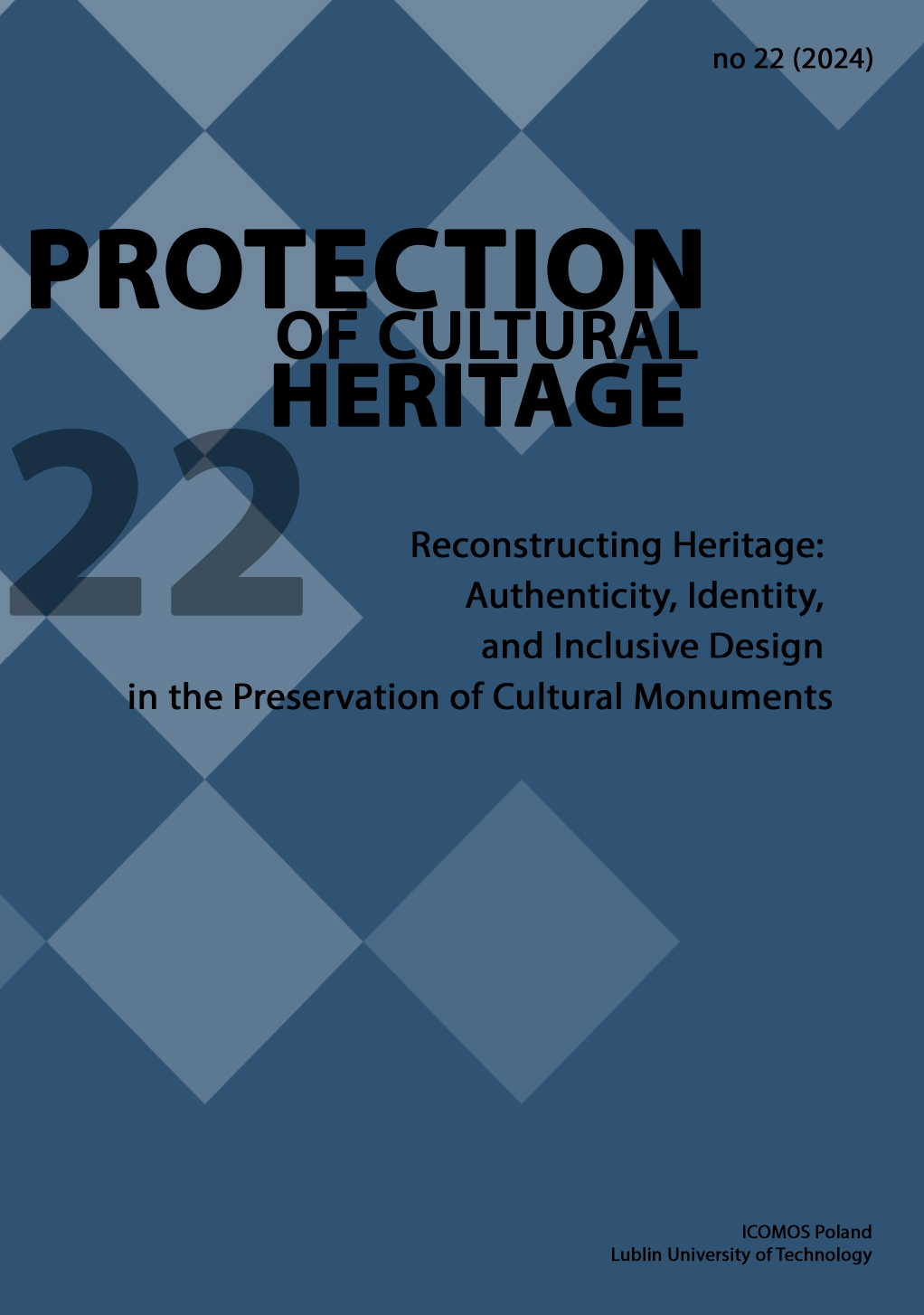Narracyjne podejście do żywego dziedzictwa
Nigel Walter
nigelesque@gmail.comDepartment of Archaeology, University of York, The King's Manor, York YO1 7EP (Wielka Brytania)
https://orcid.org/0000-0002-1152-522X
Abstrakt
W artykule podjęto próbę określenia ram teoretycznych dla potrzeb żywego dziedzictwa. ICCROM jest liderem w opracowywaniu praktyk konserwatorskich w zakresie żywego dziedzictwa, jako miejsca kultu religijnego. Do tej pory nie podjęto jednak próby stworzenia podstaw teoretycznych dla tych praktyk. W miejsce wciąż dominującego definiowania (przynajmniej w większości zachodnich praktyk) obiektów zabytkowych głównie pod kątem ich historycznych wartości, niniejszy artykuł proponuje podejście narracyjne, które pozwala miejscom lub budynkom pozostać w ich kontekście kulturowym / religijnym, przy jednoczesnej akceptacji zachodzących zmian. Choć podejście to wywodzi się ze źródeł zachodnich, uznaje konieczność zrozumienia tradycji innych regionów świata. Każdy teoretyczny model dla żywego dziedzictwa musi odpowiadać na zasadnicze pytanie, w jaki sposób istniejące budynki przetrwają różnice pokoleń, to znaczy ciągłość między przeszłością, teraźniejszością i przyszłością. Ponieważ współczesność pociąga za sobą zobowiązanie do radykalnego zerwania z przeszłością, takie podejście musi angażować zasoby przednowoczesności, aby rozwinąć (a może przywrócić) nienowoczesne rozumienie tradycji jako rozwojowej i twórczej. Główne źródła wykorzystane w badaniu proponowanego podejścia narracyjnego obejmują rehabilitację tradycji Alasdaira MacIntyre'a, rozwój hermeneutyki filozoficznej Hansa-Georga Gadamera oraz prace Paula Ricoeura nad narracją i czasem.
Słowa kluczowe:
Tradycja, ciągłość, Alasdair MacIntyre, Hans-Georg Gadamer, Paul RicoeurBibliografia
Araoz, G. F. (2011). Preserving heritage places under a new paradigm. Journal of Cultural Heritage Management and Sustainable Development, 1(1), 55–60. https://doi.org/10.1108/20441261111129933
Google Scholar
Australia ICOMOS. (2013). The Burra Charter: The Australia ICOMOS charter for places of cultural significance, 2013. Burwood, Australia: Australia ICOMOS.
Google Scholar
Brand, S. (1994). How buildings learn: What happens after they’re built. New York and London: Viking.
Google Scholar
Burke, E. (2001). Reflections on the Revolution in France. Stanford, CA: Stanford University Press. (Original work published 1790)
Google Scholar
Cattermole, P. (Ed.). (2007). Wymondham Abbey: A history of the monastery and parish church. Wymondham: Wymondham Abbey.
Google Scholar
de Man, P. (1970). Literary history and literary modernity. Daedalus, 99(2), 384–404.
Google Scholar
Dowling, W. C. (2011). Ricoeur on time and narrative: An introduction to Temps et récit. Notre Dame, IN: University of Notre Dame Press.
Google Scholar
Gadamer, H.-G. (1989). Truth and method (2nd, rev. ed.; J. Weinsheimer & D. G. Marshall, Trans.). London: Sheed and Ward. (Original work published 1960)
Google Scholar
Historic England. (2008). Conservation principles: Policies and guidance for the sustainable management of the historic environment. London: English Heritage.
Google Scholar
Lamarque, P. (2014). The opacity of narrative. London: Rowman & Littlefield International.
Google Scholar
Lamarque, P., & Author. (2019). The application of narrative to the conservation of historic buildings. Estetika: The Central European Journal of Aesthetics, LVI/XII(1), 5–27.
Google Scholar
Latour, B. (1993). We have never been modern (C. Porter, Trans.). Cambridge, MA: Harvard University Press.
Google Scholar
Lipp, W., Štulc, J., Szmygin, B., & Giometti, S. (Eds.). (2012). Conservation turn - return to conservation: Tolerance for change, limits of change. Firenze: Edizioni Polistampa.
Google Scholar
MacIntyre, A. C. (1985). After virtue: A study in moral theory (3rd ed.). London: Duckworth.
Google Scholar
Petzet, M. (2009). International principles of preservation. Berlin: Hendrik Bäßler Verlag.
Google Scholar
Poulios, I. (2014). The past in the present: A living heritage approach—Meteora, Greece. London: Ubiquity Press.
Google Scholar
Ricoeur, P. (1980). Narrative time. Critical Inquiry, 7(1), 169–190. https://doi.org/10.2307/1343181
Google Scholar
Ricoeur, P. (1984). Time and narrative, vols 1–3 (K. McLaughlin & D. Pellauer, Trans.). Chicago, IL and London: University of Chicago Press.
Google Scholar
Stiefel, B. L., & Wells, J. C. (Eds.). (2014). Preservation education: Sharing best practices and finding common ground. Hanover, NH: University Press of New England.
Google Scholar
Strong, R. (2007). A little history of the English country church. London: Jonathan Cape. (4631753).
Google Scholar
Walter, N. (2017). Everyone loves a good story: Narrative, tradition and public participation in conservation. In G. Chitty (Ed.), Heritage, conservation and communities: Engagement, participation and capacity building (pp. 50–64). Abingdon and New York: Routledge.
Google Scholar
Walter, N. (2020). Narrative theory in conservation: Change and living buildings. Abingdon and New York: Routledge.
Google Scholar
Wijesuriya, G. (2015). Annexe 1: Living heritage: A summary. Retrieved January 9, 2017, from http://www.iccrom.org/wp-content/uploads/PCA_Annexe-1.pdf
Google Scholar
Wijesuriya, G., Thompson, J., & Court, S. (2017). People-centred approaches: Engaging communities and developing capacities for managing heritage. In G. Chitty (Ed.), Heritage, conservation and community: Engagement, participation and capacity building (pp. 34–49). Abingdon and New York: Routledge.
Google Scholar
Autorzy
Nigel Walternigelesque@gmail.com
Department of Archaeology, University of York, The King's Manor, York YO1 7EP Wielka Brytania
https://orcid.org/0000-0002-1152-522X
Statystyki
Abstract views: 937PDF downloads: 780 PDF downloads: 71
Licencja

Utwór dostępny jest na licencji Creative Commons Uznanie autorstwa – Na tych samych warunkach 4.0 Miedzynarodowe.








